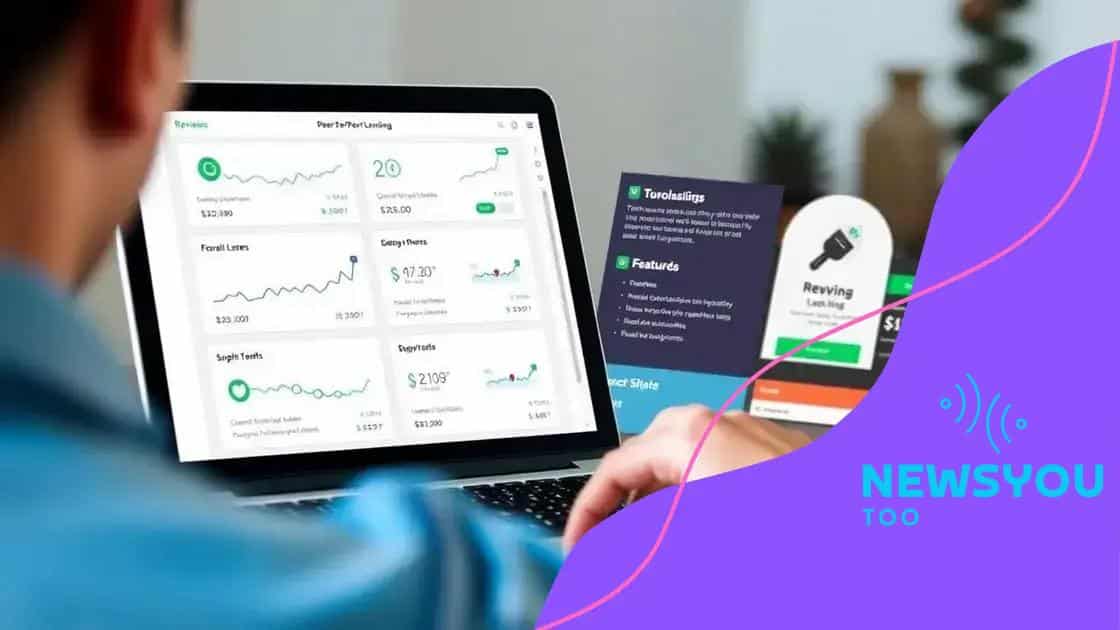How to build wealth through peer-to-peer lending

Anúncios
Peer-to-peer lending allows individuals to lend money directly to borrowers through online platforms, offering potentially higher returns compared to traditional banking, but it comes with risks such as defaults and liquidity issues.
How to build wealth through peer-to-peer lending opens a unique avenue for investors seeking alternative income. Have you considered the potential for regular earnings by connecting with borrowers directly? In this guide, we’ll dive into the essentials of this investing trend.
Anúncios
Understanding peer-to-peer lending basics
Understanding peer-to-peer lending is essential for anyone interested in growing their wealth. This innovative lending model connects borrowers directly with lenders, often cutting out traditional financial institutions. As investors, comprehending the basics can help you make informed decisions about your investments.
This model works by allowing individuals to lend money to others through a digital platform. In return, lenders earn interest on the amount they lend. It’s a straightforward and appealing option for those looking to diversify their portfolios.
Key Features of Peer-to-Peer Lending
Several elements make peer-to-peer lending unique:
Anúncios
- Low entry barriers: You don’t need a massive amount to start investing.
- Flexibility in terms: Choose the amount and duration that suits you.
- Higher potential returns: Interest rates can be more favorable than traditional savings accounts.
Despite its advantages, it’s vital to understand the potential risks involved. These risks include the possibility of borrower defaults and market fluctuations affecting returns. Keeping this in mind, many platforms assess borrowers’ creditworthiness, providing insight into their reliability.
How It Works
The process is simple and user-friendly. You sign up on a lending platform, browse loan requests, and decide which ones to fund. Most platforms provide ratings or assessments for borrowers, helping you evaluate the risk. By doing this, you can allocate your funds to projects that align with your investment goals.
Many platforms also offer tools to help you manage your investments and track your earnings. By monitoring your portfolio, you can make adjustments as needed, optimizing your potential returns while minimizing risks. As you become more comfortable with peer-to-peer lending, consider expanding your strategy to include different types of loans.
Overall, understanding how peer-to-peer lending functions equips you with valuable insights into maximizing your investment opportunities.
The benefits of peer-to-peer lending

The benefits of peer-to-peer lending are numerous and can significantly impact your financial portfolio. This lending model provides a fresh approach to investing, connecting individuals directly with borrowers. Many people find it an attractive option due to its potential for high returns and accessibility.
One of the most appealing aspects of peer-to-peer lending is the opportunity for diversified investments. By funding multiple loans, you can spread your risk across different borrowers. This not only helps mitigate potential losses but also maximizes your chances of earning interest.
Higher Returns
Compared to traditional savings accounts, peer-to-peer lending often offers higher interest rates. This makes it an attractive investment option for those looking to grow their wealth quicker. While bank interest rates may barely keep up with inflation, peer-to-peer platforms often provide returns ranging from 5% to 12% or more, depending on the risk profile of the loans.
- Attractive income stream: Monthly payments from borrowers can create a steady cash flow for lenders.
- Diverse borrower options: Choose to fund personal loans, business loans, or real estate investments.
- Reduced overhead costs: With fewer intermediaries, lenders and borrowers can benefit from lower fees.
Another key benefit is the flexibility that peer-to-peer lending provides. Lenders have the freedom to invest small amounts in multiple loans, tailoring their risk exposure according to their preferences. It allows for more control over where your money goes and what kinds of risks you’re willing to take.
Community Impact
Investing in peer-to-peer lending can also create a positive impact on communities, as loans are often granted to individuals and small businesses that may not qualify for traditional bank financing. This support can foster local economies and create jobs, resulting in a win-win scenario for both the lender and the borrower.
Overall, the combination of attractive returns, flexibility, and the potential for community development makes peer-to-peer lending a compelling option for modern investors.
Risks involved in peer-to-peer lending
Risks involved in peer-to-peer lending are important to consider before diving into this investment opportunity. Like any investment, understanding potential challenges can help you make informed choices. While peer-to-peer lending can offer great returns, it is essential to know the risks to protect your investments.
One significant risk is the default risk. This occurs when borrowers fail to repay their loans. Unlike traditional banks, where loans may be insured, peer-to-peer loans often lack such security. Before investing, it’s critical to evaluate the borrower’s creditworthiness as much as possible.
Market and Economic Risks
Economic downturns can also impact repayment rates. When the economy suffers, borrowers may struggle to meet their financial obligations. This can lead to an increase in defaults, affecting your earnings. Diversifying your portfolio can help mitigate this risk.
- Interest rate fluctuations: Changes in interest rates can affect the attractiveness of peer-to-peer loans compared to other investment options.
- Regulatory changes: New laws or changes in lending regulations can impact how peer-to-peer platforms operate.
- Platform risks: If the lending platform goes out of business, lenders may lose their investments.
Another risk worth noting is the possibility of liquidity issues. Unlike stocks or bonds, peer-to-peer loans are not easily sold or turned into cash. Depending on the platform’s terms, your funds may be tied up for extended periods, limiting access to your money.
Limited Control Over Borrowers
As a lender, you often have limited control over borrower decisions. Managing defaults or late payments can be frustrating, as you rely on the platform to handle these situations. Understanding platform policies related to collections can be beneficial.
Ultimately, while peer-to-peer lending offers attractive potential returns, it is essential to approach it with caution. Be sure to assess and understand all associated risks before making investments, as this knowledge will be crucial in your investment journey.
How to choose a reliable platform

Choosing a reliable platform for peer-to-peer lending is crucial for successful investing. With many options available, finding the right platform can enhance your experience and safeguard your investments. It’s vital to know what to look for to make an informed decision.
Start by assessing the platform’s reputation. Look for reviews and ratings from other users. Reputable platforms typically have positive feedback and high ratings. Understanding user experiences can provide insight into how well the platform operates.
Fees and Costs
Next, consider the fees associated with the platform. Many peer-to-peer lending sites charge fees for services, which can impact your overall returns. Make sure to read the fine print regarding origination fees, service fees, and withdrawal fees. Compare different platforms to find options that minimize these costs.
- Transparent pricing: Choose platforms that clearly outline their fee structure.
- No hidden fees: Look for transparency in all costs to avoid surprises.
- Value for fees: Ensure the benefits offered justify the fees charged.
Another key factor is the variety of loan options available. Reliable platforms should offer different types of loans to fund. This allows you to diversify your investments and adjust your risk profile according to your preferences. Check if the platform provides personal loans, business loans, or real estate loans.
Borrower Verification Practices
Examine how the platform verifies borrowers. A strong verification process can minimize your risk as a lender. Look for platforms that conduct thorough background checks and credit assessments. The more information the platform gathers, the better it can ensure that you are lending to reliable borrowers.
Finally, ensure the platform has a user-friendly interface. You want a site that is easy to navigate, making it simple to review loan requests and manage your investments. A seamless experience enhances your investment journey and helps keep track of your growing portfolio.
Tips for maximizing returns in peer-to-peer lending
Maximizing returns in peer-to-peer lending involves strategic planning and informed decision-making. With the right approach, you can increase your earnings potential while managing risks effectively. Here are some practical tips to help you get the most out of your peer-to-peer investments.
First, it’s essential to diversify your investments. Investing in multiple loans across various borrowers spreads your risk. By not putting all your money into one loan, you can protect yourself from losses if a single borrower defaults.
Assess Borrower Profiles
Take the time to review borrower profiles thoroughly. Most peer-to-peer platforms provide credit ratings, loan histories, and other important data. Investing in borrowers with solid ratings significantly enhances the likelihood of repayment. Look for borrowers who have stable income sources and a good repayment history.
- Focus on quality: Prioritize loans with reliable borrowers over higher-risk loans, even if the latter offers attractive interest rates.
- Monitor track records: Regularly review the performance of the loans you’ve invested in to identify patterns.
- Consider loan types: Different types of loans may offer varying levels of risk and return. Understand these nuances to make better choices.
Secondly, stay up-to-date with market trends. The peer-to-peer lending landscape can shift due to economic conditions, regulations, and borrower behavior. By keeping an eye on these factors, you can adjust your strategies to capitalize on emerging opportunities.
Make Use of Automated Investing
Many platforms offer automated investing tools that allow you to set criteria for loans you want to invest in. This can save time and help you maintain a diversified portfolio. Setting up auto-invest features can also ensure you continually reinvest earnings for compound growth.
Lastly, be patient and adopt a long-term perspective. Peer-to-peer lending often rewards those who are willing to wait for returns. Regularly reassess your strategy and make adjustments as necessary, but don’t panic over short-term fluctuations.
Conclusion: Peer-to-peer lending is an exciting opportunity to grow your wealth, but it’s also important to approach it with knowledge and caution. By understanding the basics, evaluating risks, and choosing reliable platforms, you can maximize your returns. Diversifying your investments, monitoring trends, and being patient are key strategies for success in this evolving landscape. As you consider this investment avenue, remember to stay informed and agile, adapting to market changes as they arise.
FAQ – Frequently Asked Questions about Peer-to-Peer Lending
What is peer-to-peer lending?
Peer-to-peer lending connects borrowers directly with lenders through online platforms, allowing individuals to lend money without traditional banks.
How do I choose a reliable peer-to-peer lending platform?
Look for platforms with positive user reviews, transparent fee structures, and strong borrower verification processes to ensure a safe investment.
What are the risks involved in peer-to-peer lending?
Risks include borrower defaults, fluctuating interest rates, and potential liquidity issues. It’s important to assess and manage these risks before investing.
How can I maximize returns in peer-to-peer lending?
Diversifying your investments, researching borrower profiles, and staying informed about market trends can help improve your returns in peer-to-peer lending.





